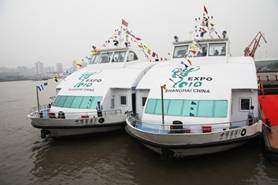Hi Everybody!
There were some questions posted by Ian and Grange Academy earlier and I’ve been asked to further elaborate on the travel and environment parts and turn it into a blog post, so here goes:
Travel
世博会期间有哪些交通工具可供使用? What sort of transport is available to the Expo?
Although there are roads in the Expo grounds, private cars are not allowed. The Expo is easily accessible through the metro, public buses and taxi, but even then, visitors must disembark at the gate to pass through the security checks.
Despite its massive size, walking is still the predominant form of transport for visitors at the Expo. Indeed, some people spend the whole day just walking around at the fair grounds to look at the exterior of the pavilions. Except for certain areas, bicycles and rollerblades are also prohibited. This is to prevent minor accidents from people running into each other.
Although there are shuttle buses and electric golf carts, most attendees will be walking throughout their time at the Expo. An exception to this is the ferry system, which allows visitors to travel across the Huangpu River to see both Expo sites.
Here’s a couple of pictures showing the ferries available:

Environment
中国人怎么试图营造出世博的和谐环境? How are the Chinese trying to make the Expo environmentally friendly?
With the Expo theme of “Better City — Better Life,” much of this year’s World’s Fair is intrinsically tied to environmental awareness. Indeed, the main focus of many pavilions are environmentally based, and many are constructed with recycled or low-carbon materials. According to Expo organisers, some of the common seating areas at the site are also constructed with recycled materials, like old milk packages, handbags, barrels, and traffic signs. Vehicles I describe in the second question below are also zero-emission.
As well, the Expo boasts China’s largest solar power system, producing 4.7 megawatts. It’s estimated that the amount of energy collected will be able to provide free electricity to several thousand households for a whole year. Here’s a picture of a worker walking alongside the sprawling solar power system; you can see the China Pavilion in the distance:
According to CCTV, the electricity generated by the solar panel systems at the Expo can reduce carbon dioxide discharges by 2,800 tons.
为什么英国选择“种子圣殿”作为其代表? Why did Britain choose the seed cathedral to represent itself?
Each participating entity will have their own committee that will decide on the direction of their own pavilion. Sometimes these choices will be decided based on macro policy, or interpretation of the Expo theme. The final selection is ultimately arbitrary by nature, and most pavilion exhibitors see this as a chance to create something innovative and creative.

But I think Thomas Heatherwick, the chief architect for the UK Pavilion, will probably have a better answer: “Rather than being a straightforward adert for the UK, we want our pavilion to give each person a more profound understanding of the richness of contemporary UK culture. Nothing has more potential than seeds,” said Heatherwick, according to Beijing Today. “Seeds in the rods are like dinosaurs trapped in amber,” he said.
“We can protect the future of mankind and the environment by harnessing the power of nature through seeds.” When I think about the UK, a lot of things come to my mind. But the environment, is admittedly, not one of them. And I think that’s the point that Heatherwick is trying to make with the Seed Cathedral: The UK has a lot of things to offer, including its natural resources; so the abundance of different seeds at the pavilion represent diversity and the environment.


